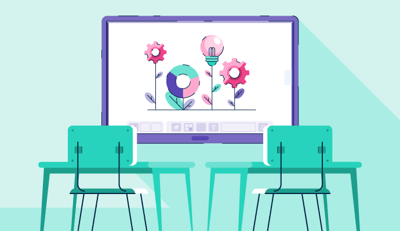

Software has been weaving its way into the fabric of the education sector for quite some time.
Although the change hasn’t been as rapid or as drastic as that experienced by other industries — like media, professional services, and advanced manufacturing — educational institutions are recognizing that implementing educational software delivers varying benefits.
These benefits include increased collaboration, improved student engagement levels, and the implementation of clear-cut communication channels between students, teachers, and parents.
Modern classrooms are already full of technology. Students use mobile internet-connected devices in the classroom, have their devices monitored and managed by classroom management software, have access to course information and assignments via learning management systems, track their grades via a student portal in their school’s student information systems.
As the scope and efficacy of educational software solutions increases, the amount of technology in the classroom will continue to increase. An increase in the amount of technology in the classroom can give students, teachers, administrators, and parents the tools necessary to improve efficiency and efficacy in the classroom.
Software can promote significant collaboration between students in the classroom. Classroom management software, in particular, is designed to help curb distractions in the classroom while creating avenues through which students can collaborate on assignments.
Solutions in the classroom management category often contain features that allow students to work on assignments together and communicate on in-class channels. They also provide teachers with tools to monitor all of the collaboration that happens, helping them ensure their students are staying on task throughout the duration of class.
Lagging student engagement is an issue for many education professionals, and certain categories of education software are designed precisely for the purpose of improving those engagement levels. Technology like augmented reality software and virtual reality software can greatly increase engagement levels among students who otherwise might be lacking a desire to engage with the material.
Imagine the wonder of a classroom full of third-graders that get to put on VR headsets and dive into the world of a sunken shipwreck. Or a high school class that is able to journey to Angkor Wat and stroll among the ruins during a lesson on the civilizations of Southeast Asia. Giving students more interactive tools with which to learn is a surefire way to improve engagement levels.
| Related: Introducing new software to the classroom is a work in progress. Discover the top 5 education technology trends to learn what's popular amongst other educators. |
Digital content is the type of education technology that can help the most with retention. When coupled with an artificially intelligent tutor, digital content can assess what difficulties an individual student is having with the given material. The assistant can then rearrange the content or assessments to allow the student to focus on shoring up their areas of weakness, giving them a clear path to improve their knowledge of a given subject.
Teachers can create, distribute, and grade assessments via assessment software. There are even artificial intelligence powered grading tools that are able to accurately grade write-in answers and multiple-choice assessments. The glut of tools in the average teacher’s arsenal is only going to increase, particularly as the technology improves.
There is potential for AR/VR solutions to achieve omnipresent status in the average classroom, greatly improving engagement levels amongst students. Teachers can also utilize student information systems (SIS) as grade books and can easily access all student information in a single place. They can use that information to identify at-risk students, students that need more attention, and leverage that information to put together a comprehensive strategy regarding how to best set them up for success.
Communication is a broad benefit to attribute to education software, but solutions designed for the education space improve communication between every party involved.
Administrators have clear-cut communication channels to both teachers and parents via their student information systems (SIS). Teachers can communicate directly with students via their learning management system (LMS), SIS, or classroom management software.
Parents have multiple official channels of communication through which to address their questions and concerns. The creation and implementation of a multitude of easily accessible communication tools creates a buffer between parents and teachers. Teachers should no longer feel the need to hop on the phone to discuss a student-related issue unless it’s absolutely necessary.
All of these communication tools serve to strengthen the bonds between the various parties engaged in the learning process and stop any ambiguity or miscommunication.
There have always been concerns from hardliners about software and tech use within the classroom, but these concerns have largely been assuaged by applications designed specifically to moderate classroom tech use.
Classroom management software in particular is designed to keep students on task and focused on the material at hand while simultaneously promoting in-class collaboration. Technology use in the classroom is here to stay. The amount of solutions designed to keep students on task will increase, and their quality will improve.
The classroom of the future is going to look quite a bit different than the classrooms of today. The traditional model of education consists of a teacher lecturing at the front of the classroom about the subject matter, while students furiously copy down notes until at some point in the semester a test is given. This model is going to be a thing of the past as teaching methods change with the influx of edtech.
As the switch to all-digital material is made, paper materials will be a distant memory. Even gym classes can benefit from technology! Artificial teaching assistants will answer the brunt of questions directed at teachers. AR/VR will infuse the classroom with exciting new tools designed to increase student engagement and understanding. Students will interact with material in different ways, heeding the advice of their digital mentors.
Individualized learning experiences will be the norm, as students are given different portions of the material to focus on. The specific material they are given will depend on their performance and their digital learning assistant’s experience. The future of the classroom is bright and bursting with all of the potential that educational software applications present.
If you're looking for solutions to implement in your classroom, check out our education software categories.
Patrick is a Senior Market Research Manager and Senior Analyst (Fintech and Legaltech) at G2. Prior to G2, he worked in a variety of roles, from sales to marketing to teaching, but he enjoys the opportunity to constantly learn and grow that the tech industry provides. Outside of work, Patrick enjoys reading, writing, traveling, jiu-jitsu, playing guitar, and hiking.
It takes a special type of person to teach for a living.
 by Mary Clare Novak
by Mary Clare Novak
The right software can turn a lackluster classroom experience into one that’s engaging,...
 by Mara Calvello
by Mara Calvello
The world of education has seen a significant amount of advancements since its establishment...
 by Mary Clare Novak
by Mary Clare Novak
It takes a special type of person to teach for a living.
 by Mary Clare Novak
by Mary Clare Novak
The right software can turn a lackluster classroom experience into one that’s engaging,...
 by Mara Calvello
by Mara Calvello
Never miss a post.
Subscribe to keep your fingers on the tech pulse.



